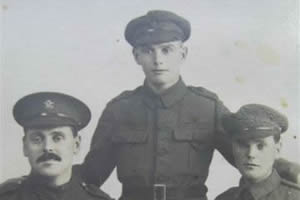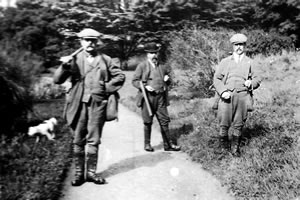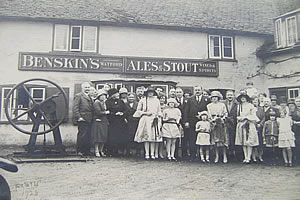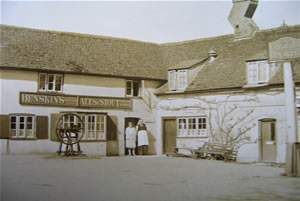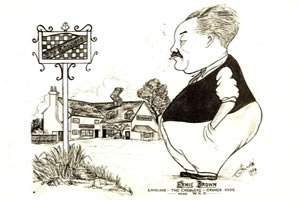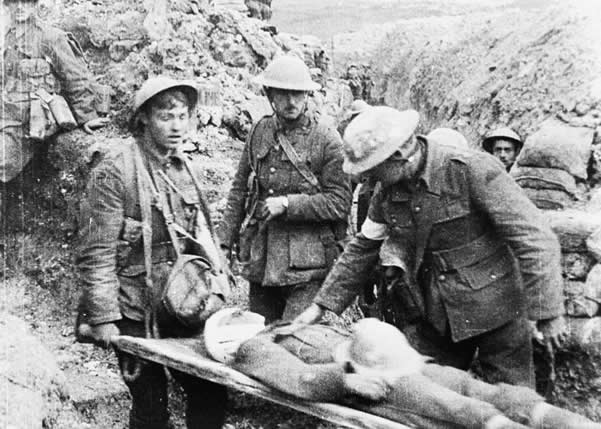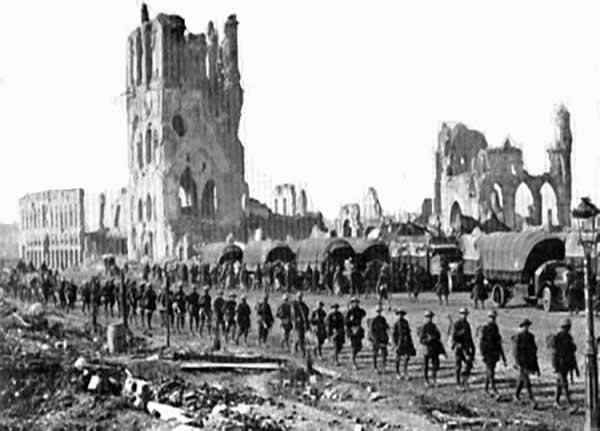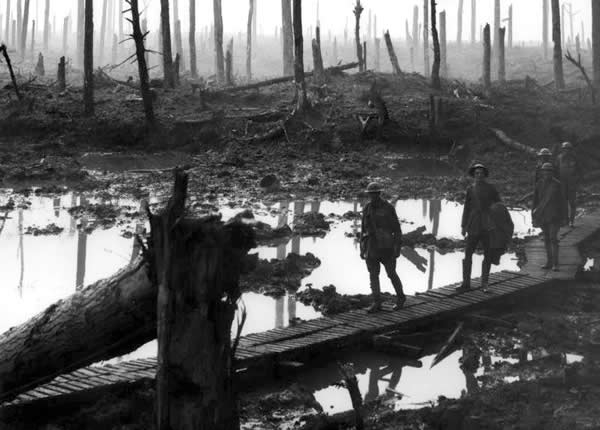Cromer Hyde 1914-1918 by H.J. Brown
by H.J. BrowNA friend of Lemsford Local History Group is Jack Brown who was bought to my attention with his article Life in a Victorian gamekeepers cottage.Jack kindly contributed to our display with the article below, and extract from his website:. Watch our slide show and click on image to enlarge
- Can you Help
- Parish Magazine
Cromer Hyde 1914-1918 by H.J. Brown
A friend of Lemsford Local History Group is Jack Brown who was bought to my attention with his article Life in a Victorian gamekeepers cottage. I offered to build him a website to showcase his memories and family history. His website is http://www.hjbrownhistorian.co.uk Jack kindly contributed to our display with the article below, and extract from his website:
Cromer Hyde 1914-1918 by H.J. Brown
By the time of the Great War 1914-1918, the Brown family who lived in Cromer Hyde Lane had left their old Victorian cottages at the far end of the lane and moved to a new house, not so far up the lane, built for them by Lord Mount Stephen. It was larger with a bigger garden to grown all their vegetables and they must have been delighted, particularly as it had a pump of its own, thus releasing the oldest children from the long walk to the nearest pump. The oldest members of the family had already left home, but Grannie was still to have two more children, Stephen born in 1914 only to die in 1924 and Esme Jane born in 1918 and dies in 1919.
Ernest, the oldest son, born in 1891, had left home and gone into service and became a footman for the Lord and Lady Harrington of Elvaston Castle, Derbyshire. He had been highly thought of by the family and had travelled abroad with them. Frederick, born in 1896 had also gone into service and became a footman.Ern and Freds dad was Alfred Henry Brown. The two brothers together with their cousin Samuel Turner, son of my Grandfather’s sister Edith, decided to volunteer and together they joined the Prince of Wales Rifles. They all served in France and tragically at the Battle of the Somme, Sam was killed, Fred was wounded in the head, arm and knee and Ern suffered shell shock.
My father Herbert born in 1892 had marred my mother at Lemsford in 1913 and was a Police Officer at Southwark in London, a reserved occupation. In 1918 he joined the Machine Gun Corps but the war ended before he went to France and he went back to the Police.
Auntie May, my father’s sister, born in 1899 had gone into service and for some of the war years worked in the kitchens at Hatfield House, home of the Salisbury’s. Her sister Eva born 1901 was a housemaid at Brocket, but the other children were still at home.
I expect that life in the district must have carried on much as usual, occasionally shocked by the war news or when a local man was killed or wounded. As it was in the last war, country folk had access to rabbits, pigeons and their own vegetables and did not feel the pinch of rationing as much as folk in the cities. One thing that did affect them all were the Zeppelin raids because although they were not the target, they could hear them overhead. When the Germans started to bomb London, their airships flew west of the North Sea and when they were over land, turned south, finally to pick up the Thames, clearly visible on moonlit nights. This meant that as they approached North London they often went over parts of Hertfordshire and the drone of their engines must often have been heard in the Hatfield area. On one occasion, bombs were dropped on the Essendon area and the two young daughters of the village blacksmith were killed, much to the anguish and anger of local people. I think they were relatives of the Flitney family who lived in Cromer Hyde.
The Germans started bombing England from Zeppelins in 1915 and caused a great and fearful impression on the population. The raids were very successful and we developed anti-aircraft guns to meet the threat, but they were not that effective in turning the raiders back. Then in September 1916 the airship SL11 was intercepted by Pilot Officer Robinson and, using a newly invented bullet in his Lewis gun, set it alight and it fell at Cuffley. It was not an airship designed by Count Zeppelin, but had a fuselage made of wood, re-enforced with steel wire. That was all that was left on the ground after the fire. The people in the Hatfield area would have had a grandstand view. There was great jubilation in the country, but this was to be surpassed three weeks later. On 2nd October 1916 a fleet of eleven Zeppelins left Germany to bomb England, but conditions were bad and caused them to turn back due to icing. The lead Zeppelin L31 was one of the latest design and was captained by Heinrich Mathy, a most experienced and determined pilot. He pressed on and approached London from the direction of Hertfordshire. The Zeppelin was then caught in the searchlight and eventually in a cone of lights. This gave the anti-aircraft gunners a better chance of hitting their target and there were shell bursts all round the ship. At this stage, Mathy must have decided to abort his mission and when he was over Cheshunt he pressed a button that released all 50 bombs at once. Some houses were damaged and acres of greenhouses had their glass all broken. He then appeared to change course westward, trying to escape the searchlight and the gunfire and passed over the Hatfield area. He was then attacked by Pilot Office Tempest who targeted the Zeppelin in the cone of searchlights and almost immediately it burst into flames and crashed at Potters Bar. The bodies of the crews of both Cuffley and Potters Bar airships were interred at Mutton Lane cemetery, Potters Bar. Many local people were angry that they were given full military honours, possibly because remembering the death of the two girls at Essendon on an earlier raid. All Hertfordshire links with the Zeppelins were finally severed after the last war when in 1961 the bodies were exhumed and taken to a new German War Cemetery at Cannock Chase.
Ernest C Brown
Date Born 5/11/1890 Age in 1914 24 Regiment: 1/15th Civil Service Rifles
Frederick G Brown
Date Born 15/6/1896 Age in 1914 18 Regiment: 1/15th Civil Service Rifles
Ern and Freds dad was Alfred Henry Brown was born at Basingstoke, Hampshire on April 3rd 1867. He worked for Lord Mount Stephen at Brocket Park, Lemsford, Herts. Where he was again under keeper, although it was a much bigger place and famous for its game birds. The future King George the Fifth often went to Brocket on shoots and there is a well known family story about an argument among the visitors after dinner about one of the hundreds of birds that had been shot. They asked for the bird to be found and brought to the drawing room but, of course, the keepers couldn’t do this. Never the less, they found a bird that fitted the bill and this was sent up and nobody knew the difference
Lemsford Local history group has tried to describe what life was like in the parish between 1914 -1918. The best account I have seen is by Jack and below are a few extracts:
What was Cromer Hyde Like?
The cottage was one of a semi-detached pair at the end of the lane, which zigzagged for about a mile from the Chequers Inn (now called the Crooked Chimney) on the road between Lemsford and Wheathampstead. Much of the lane ran between fields, as it still does, and the houses were mainly lived in by farm labourers and the like, with Cromer Hyde Farm at the end of the lane. It must have been typical of thousands of English lanes at that period, not made up and with grassy banks and hedgerows on either side.
A typical Rural dwelling in Lemsford parish
The pair of cottages were identical, each with two rooms up and two rooms down, and were built of brick with tiled roofs. The front gardens were small with a white picket fence and gates , but the back gardens were large. The back room downstairs was the kitchen , with a small range for cooking and a large strong kitchen table with chairs. There was a meat safe on the wall, much used before the coming of refrigerators. In one corner was a simple flat stone sink, which emptied into a large bucket underneath. The front room downstairs was the parlour, containing the best bits of furniture One of the bedrooms was used by the children with girls in one bed and boys in the other. The beds were large and strong with thick feather mattresses. The other bedroom was used by my grandparents and the youngest baby. Each room had a washstand with a large bowl on top and a jug standing in it
Food and Drink
Like most country people, they had chickens in a run kept on scraps and chicken feed, and the children gave them all names. Eggs were always assured for the kitchen and as the hens grew old there was an occasional roast which was very welcome. When the pig had to be killed a local butcher came and cut it up and only the squeal was wasted. My grandmother then salted down joints by rubbing in salt petre and salt and then hung them up wrapped in old curtains in the outhouse. Relatives and friends shared in the abundance of meat and reciprocated when their pigs, in turn, were killed. Meat came from the butcher in Hatfield, who called twice a week in a pony and trap, as did the baker. Milk and butter came from the farm in Brocket and groceries were purchased at a little shop in Lemsford or in Hatfield.
Clothing a large family
Clothing a large family was always a problem and clothes were handed down to get maximum wear. They were eventually wore out and it was common to make rag rugs by cutting up heavy material and sewing them on to a sack---they made good covering for floors but they did tend to hold the dirt. Jumble sales did not exist as working class families never parted with anything until it was worn out or passed on to relatives or friends. Each Christmas, Lord Mount Stephen used to give a length of dress material for each girl and a strong woollen jersey for each boy. Sacks were boiled to make them soft and then they made very strong aprons and had many other uses.
Boots and shoes made by the village shoemaker Wilmot in Lemsford were for everyday use and repairs were usually done by the Father of the Family. The method used was called clumping and entailed cutting a leather sole roughly the size and nailing it over the existing sole. It was the trimmed to size with a knife and smooth at the side with a piece of broken glass. Finally it was sealed with hot wax applied with a special iron ,and then given a generous covering of steel studs and blakeys to make sure they took a lot of wear before it got through the new leather, when the process was .repeated
Utilities and garden
There was no water laid on and no pump in the garden, so when they were big enough this was a job the boys had to do and there was an old fashioned yoke so they could carry two buckets at a time, down the lane to the well. This meant that water was a very precious thing and not to be wasted--how different our attitude today when we get it at the turn of a tap. Naturally, there were no sewers either, and toilet arrangements were a shed in the garden with a seat and a large bucket underneath. The men and boys went behind the hedge most of the time and when the bucket was full it was taken to a midden at the end of the garden and in due course dug into the soil. The large garden provided, practically all of the family’s vegetables and the adults worked to provide produce throughout the year. Potatoes, Swedes and carrots were stored in clamps in the garden and onions in the shed. Heating was by coal or wood, the former being supplied by coal merchants in their horse drawn carts from Hatfield coal yards by the station. The out house also had a copper, much used on wash days, and a galvanised bath tub for the weekly bath
There was always a large stew pot on the stove and in it went any meat scraps left over. The boys were encouraged to kill with stick or stone, birds and rabbits which were quickly cleaned and popped into the stew pot. On Sundays, the family went to church at Lemsford in the morning, the children went to Sunday School in the afternoon and very often they all went to Evensong too. For the parents there was a drink at the” Chequers “or “The Long Arm and the Short Arm” in Lemsford and perhaps lemonade or biscuit for the children.
Education, Medication and Transport
The children went to a village school at Lemsford , which is still there today. There were no school meals in those days, so having walked two miles to school the children stayed all day and took something for their lunch, although sometimes my grandmother would take it at mid-day. Discipline was strict at school but it gave the children a good basic education of the three Rs
In the case of serious illness, the doctor would come from Hatfield in his pony and trap, but for everyday illnesses and ailments old country remedies were used, passed on from generation to generation. Headaches were treated by dipping a rag in vinegar and tying it round the head, or if it was a summer headache my granny recommended crushing a bit of washing soda to powder, putting it on the thumb and sniffing it up the nose. I tried this once and the effect of the soda on the tender skin almost blew my head off. I certainly forgot the headache! Iodine was always applied to cuts and abrasions, and for chest colds a piece of brown paper smeared with goose grease and then applied next to the skin, under the vest. Another remedy at that time for tooth ache was to smear a piece of brown paper with grease, shake on pepper and then apply this to the cheek where the tooth was painful and wind a scarf or towel round the head. This had the effect of making the cheek very hot and uncomfortable---so much so that the toothache became secondary. Rosehip syrup was used for sore throats and colds.
If the family went visiting it meant walking and they naturally went by the shortest route, be it lane, footpath or over fields and through woods. It was a common sight in those days to see a family strung out in a crocodile, parents and youngest in front and older children in the rear, all smartly dressed to impress those they were visiting
Most Documentaries and articles on the First World war focus on the lives of the men who went to war but the home front was a battle as well for the ones left behind. It was a hard life with no labour saving devices, work that paid low wages and no benefit system and a diet that kept you alive, eating was to survive not for pleasure. I thank Jack for his memories and the for recording them for ever. To read more about his life and his family go to www.hjbrownhistorian.co.uk.
.
- Do you know this Family
- Have you images or information
- If Yes to above contact us today
| Parish magazine 1914 | Home Front - News from the War - Church News |
|---|---|
| Parish magazine 1915 | Home Front - News from the War - Church News |
| Parish magazine 1916 | Home Front - News from the War - Church News |
| Parish magazine 1917 | Home Front - News from the War - Church News |
| Parish magazine 1918 | Home Front - News from the War - Church News |

